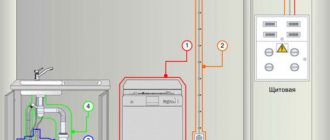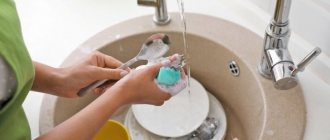After birth, a baby needs a mother. Not only for feeding, but also for comfort, emotional intimacy and relief. A mother cannot physically be constantly with her baby and offer the breast for any reason. Many babies have a very pronounced sucking reflex. They put everything into their mouths: clothes, diapers and their own fingers. It’s at moments like these that you wonder how to choose a pacifier for your child and how to properly sterilize it.
Is it necessary to boil a pacifier, and how to do it correctly?
Before directly boiling, the pacifier must be thoroughly washed, the hole blown out and rinsed. The baby bottle should initially be completely disassembled and washed thoroughly under warm running water. All these devices need to be washed with an antibacterial or simple detergent, using special small brushes. Then put everything in an enamel container and fill it to the top with water. Wait for the water to boil. Then a reasonable question arises: how long to boil the pacifier
. The answer is - boil for about 15 - 20 minutes. When the specified time has passed, drain the water, holding the accessories with the lid. Once they have cooled down, you can use them. Please note that the effect of sterilization lasts for half an hour, and therefore it is preferable to feed during this period. It is recommended to use enamel containers, since they form the least amount of limescale, which subsequently settles on the stomach walls and other organs of the baby. If you don’t have such utensils in your kitchen arsenal, you can take an old saucepan, since with frequent use this deposit settles faster and is easy to notice. To get rid of plaque, use exclusively filtered water, or install the filter directly on the tap. This will protect not only your little one, but the whole family. By the way, there is a quick option for sterilizing pacifiers; you can simply pour boiling water over them and then give them to your baby. It is not advisable to boil latex nipples, since under the influence of temperatures they can become deformed or fused.
Sterilization of bottles in the microwave, double boiler, multicooker
If you have one of these kitchen aids in your home, the process of sterilizing bottles becomes much easier.
For example, you can place baby dishes in the microwave in a plastic container of water covered with a lid. Sterilization time is about 8 minutes (depending on the power of the device). To make boiling bottles as easy as possible, you can purchase a special sterilizer for microwave ovens.
Bottles can be sterilized in a double boiler in approximately the same way. They are installed with the neck down. The duration of sterilization is approximately 5-10 minutes. A slow cooker is also suitable for this purpose. A few minutes and you're done.
It is much easier to sterilize bottles in any of these devices than in a pan of boiling water. And you don’t have to buy a special device - a sterilizer for baby bottles, which is not cheap, but will be used for just a few months.
How often should pacifiers and bottles be sterilized?
I think you understand how to boil a pacifier and bottle
, now we need to tell you how often this process should be repeated. If you feed your baby only artificial formulas, then the bottle should be boiled before and after each feeding, this will provide the baby with maximum protection from harmful bacteria that disrupt the microflora and provoke infectious diseases such as dysentery. Often, leftover food is a favorable environment for the active reproduction of viruses and bacteria. If you do not sterilize the bottle in time, then at the next meal they will all enter the child’s body. Because of this, the baby may develop diarrhea, serious intestinal disorders, etc. It is necessary to sterilize dishes for at least one year, or until the baby refuses the bottle. Over time, the child’s body will begin to produce immune cells that will independently fight microbes that cause an imbalance in the internal microflora.
Adviсe
Under no circumstances should you give your child a pacifier that has simply been rinsed with clean water. Even using bottled water can cause gastrointestinal upset in your baby. A child’s delicate body is not able to fight all microorganisms contained in raw water.
It is absolutely unacceptable to give a baby a dropped pacifier, just by wiping it with a handkerchief, for example.
Some mothers manage to put a pacifier in their baby's mouth by licking it. The bacteria contained in saliva will definitely reach the baby. The microflora of an adult can be dangerous for a newborn.
Why do you need to sterilize baby equipment?
A child’s body develops and improves over the course of one to two years, and therefore it is extremely susceptible to various diseases, including infectious ones.
If you do not follow the basic rules of sterilization, this can result in serious illnesses, food poisoning with severe symptoms (nausea, severe vomiting, bowel dysfunction, high fever, etc.). To restore the child’s health, he will have to be admitted to the hospital. Any mother is unlikely to want this, and therefore it is better to be safe. Every mother strives to create the best living conditions for her newborn child. And caring for the baby plays a big role in this, since he is not yet able to care for himself. Immediately after birth, the baby needs many items that not only allow him to develop and grow faster, but also significantly facilitate the everyday life of his parents. One of these items is a pacifier, which you not only need to choose correctly. It is also very important to know how to sterilize a pacifier. This is exactly what we will deal with in this article.
Processing and storage
The only danger that can await children and parents using them is the possibility of contracting an infection due to improper handling. Constantly treating your nipples will help you easily avoid this problem. Before electric appliances, parents simply boiled them. Now there are enough ways to sterilize nipples for newborn babies.
In order to always have a clean one at hand, you need to have 3-4 pieces in stock. To store sterile items, you can prepare a regular glass jar with a lid. How often sterilization will need to be done depends on how many pacifiers are available and how often the child uses them.
Do I need to sterilize my pacifier?
The question of how to sterilize pacifiers arises more often today than just a few years ago. And this is due, first of all, to the fact that modern technical capabilities are much richer than a couple of decades ago. In every home today you can find a lot of household appliances, which can be used not only for the purpose specified by the manufacturer, but also for other purposes. And that is why the question arises, how to sterilize a pacifier, and what can be used for this.
But before deciding how exactly to do this, you need to understand how important sterilization is. In this regard, the following facts are beyond doubt:
- Newborn babies have very weak immunity and are susceptible to attacks from any viruses and harmful bacteria. And there are a lot of them in our everyday life. That is why it is necessary to sterilize the baby’s pacifier every time until at least 3 months, preferably up to 6. Next, just new nipples before the first use.
- New, just purchased, pacifiers were subjected to long-term storage and transportation to different retail outlets. As a result of this, a huge amount of bacteria, dirt definitely accumulates on them, and if they are not in sealed packaging, various chemicals settle on the surface of latex or silicone. Therefore, you need to know how to sterilize a pacifier before using it for the first time, and be sure to do it.
Antiseptics
For emergency cases, when a clean pacifier is needed and sterilization is not available under normal conditions, special antiseptics are used. This is a pharmaceutical drug that needs to be diluted in cold water. This method causes a lot of controversy.
The antiseptic tablet is diluted according to the instructions. The pacifier should be placed in the solution for 30 minutes. The need for rinsing reduces sterility. And although the drugs are harmless, the child may refuse the pacifier treated in this way. In addition, the chemical composition of the antiseptic can cause allergic reactions in children.
When asked whether the pacifier needs to be sterilized, doctors give an unambiguous answer in the affirmative. Despite the fact that this is a troublesome matter, sterilization will protect the baby from many health problems.
Sterilization methods
Depending on how much time you have available, you can use quick or longer but effective methods. And one more factor that influences the choice of sterilization is the willingness to subject the child’s pacifier to treatment using modern technology, the safety of which has not been proven, as well as its danger.
Boiling
Boiling is the safest method, which in principle does not require you to spend a significant amount of time. This is the method our mothers and grandmothers used to sterilize nipples and pacifiers.
The sequence of your actions in this case will be as follows:
- Fill an enamel quart cup or small saucepan with water. You don’t need a lot—up to 0.5 liters is enough.
- Bring the water to a boil.
- Place a pacifier or pacifier in it.
- Boil for a few minutes - 3-5, on the lowest heat.
- Remove and place on a clean towel to dry. It is advisable to cover the products with it.
Important! The only caveat of using this technology is the accelerated wear of latex after heat treatment. Regarding silicone, it is better to check with the seller whether this method can be used for the product you have chosen.
Steaming - when time is short
Steam sterilization does not give a 100% result, but it is suitable if the child is already screaming and requires food or a pacifier to fall asleep, and you do not have another pacifier.
To sterilize a pacifier this way:
- Boil water in a kettle - it is not necessary to fill it full. Even a small amount of water inside will do.
- Take the product with tweezers.
- Hold the steam over the steam until it covers the pacifier or pacifier on all sides.
Important! 1-2 minutes of such treatment is enough for the product to be suitable for use and relatively safe for the baby.
Steamer - a modern solution
Using a steamer for sterilization is very beneficial in terms of saving time and obtaining a guaranteed result, because this technique produces exactly what is needed to neutralize pathogenic microorganisms - hot steam.
In order to sterilize a pacifier or pacifier before first or subsequent use, you must:
- Pour water into the lower compartment of the device.
- Place the necessary items on one of the levels.
- Set the timer for 2-3 minutes.
- Turn on the device and wait for the cycle to complete.
Important! Since the steamer operates from the mains, please note that energy consumption in the apartment will increase as the steamer is used to sterilize pacifiers and nipples. More precisely, it directly depends on the frequency of use of this method.
Microwave oven - is it worth sterilizing nipples using this method?
There are many opinions regarding the use of microwaves not only for sterilizing everyday items for newborns, but even for preparing food for adults. Some of them focus on the fact that there is no proven negative impact on human health when consuming products after such processing. Others argue that the electromagnetic field is still unsafe. Therefore, whether to use a microwave oven to sterilize the pacifier at home or not is up to you.
If you intend to make your daily work of caring for a baby easier in this way, proceed this way:
- Check with the manufacturer or seller whether the product you are purchasing can be treated with such an effect.
- Place pacifiers and pacifiers in a microwave-safe container.
- Pour a small amount of water there.
- Cover with a lid.
- Set the timer for 3-5 minutes.
- Remove sterilized items and dry.
Sterilization using special equipment
The modern market provides a wide selection of not only clothing, cosmetics, but also all kinds of devices for caring for newborns. One of these is a special sterilizer, with which you can make not only pacifiers and nipples, but also all bottles absolutely safe for your baby. The use of such household appliances does not cause any difficulties - just follow the instructions from the manufacturer.
Important! The only drawback that can be noted with this solution is the additional cash costs, because the unit will not be so cheap. But the safety of your child and saving your personal time are sometimes worth purchasing such a valuable device for the home. Especially if you do not plan to stop at 1 child, but are thinking about further continuation of your family.
- Even if you regularly sterilize your pacifiers, do not exceed the recommended period of use. Replace pacifiers and nipples as they wear out.
- Do not use care products of unknown origin on your newborn. Buy only certified products from reputable manufacturers.
- Observe the rules of hygiene for your baby, not being lazy in performing the necessary procedures every day. This is the only way you can protect him from most diseases and enjoy communication with a healthy and happy child.
Microwave
Should I sterilize my pacifier in the microwave? If the instructions for use do not indicate the possibility of using a microwave oven, then it is better not to do so. Plastic bottles and latex nipples can quickly become unusable.
You can only use the microwave to sterilize glass bottles for drinking and feeding.
The dishes should be placed in the oven, pour water to a third of the volume. Then you need to set the maximum power. Sterilization time is 2 minutes. Drain the water and let the bottle cool to prevent the glass from cracking.
Features of pacifiers made of different materials
Modern nipples for children are usually made of silicone or latex. They differ in color - silicone white, latex yellow. Both nipples are quite strong. But silicone ones are still considered more durable and durable. But they are also tougher. Latex ones are softer and resemble mother’s breasts, but they break down faster. Made from natural rubber, these nipples are elastic and are more popular with babies. They may have their own special taste and smell, and dirt sticks to them more easily.
As for boiling,
Silicone nipples are more heat resistant than latex products. Silicone nipples can be boiled many times, and they are odorless and tasteless. Latex pacifiers are much less resistant to high temperatures and can deteriorate if subjected to prolonged boiling, and therefore they are recommended to be changed more often than silicone ones. So, a silicone pacifier must be changed to another after 5 - 6 weeks of use, and a latex pacifier - after 4 - 5 weeks. If the nipple is damaged, it must be replaced immediately, no matter what material it is made of.
A new pacifier should always be treated. Read the instructions on the package carefully. The service life of pacifiers is also written there. You can boil them, but you shouldn’t do it for too long. Before using for the first time, a new pacifier should be boiled for about 2 - 3 minutes. When storing, pacifiers should be kept away from batteries and the sun to prevent their deformation. You should wash your pacifier at least once a day in warm water and soap and never lick it. To make the pacifier less dirty, it is recommended to hang it on a special chain with a clothespin, which can be easily attached to the baby’s clothes.
When the child reaches the age of six months, many mothers already stop sterilizing baby dishes and pacifiers. And this is quite reasonable. From now on, cleanliness can be maintained by simply pouring boiling water over the bottle and pacifier.
Well washed and dried pacifiers are stored in special transparent containers.
Babies will enjoy both latex and silicone nipples. But when the child has teeth, it is recommended to give him latex pacifiers, because silicone ones are too hard and can easily deform the teeth and injure the palate.
When choosing a pacifier
Also pay attention to its size and shape. The size, of course, should be suitable for the baby’s age. Babies need smaller nipples. The age is usually indicated on the packaging.
Pacifiers also vary in shape: they can be round, oval or orthodontic with a thin curved neck and a beveled tip. The latter are similar to the mother's nipple. To form a correct bite, experts recommend purchasing a pacifier with a flattened end or an orthodontic product with a sloping bottom surface.
Watch your baby. Perhaps he will like some pacifier and suit it better than others. Therefore, I advise you to try different nipple shapes. In addition, there are nighttime pacifiers and pacifiers with a glowing ring for the dark.
All the best!
Best regards, Sandrin.
When parents decide to give their baby a pacifier, they need to learn more about how to care for this product. Why do they need to be changed regularly, how long can you use one pacifier and how to properly sterilize it?
Mixed feeding after returning from the maternity hospital
After you have given your baby colostrum - the first milk containing many nutrients and antibodies - you can move on to mixed feeding. However, keep in mind that when your baby nurses less, your milk supply may decrease unless you stimulate it further with a breast pump.
In all cases, if you are adding formula to your breast milk within the same feeding, try to give your baby the breast first before moving on to the bottle whenever possible. At such times, ask someone else to give the bottle, not you, so that the baby will clearly remember the difference between the bottle and your breast. If you are adding the artificial mixture only in small quantities, we recommend using a pipette, syringe or teaspoon for this. This will prevent your baby from confusing the breast with the nipple of the bottle and will preserve his sucking reflex (which becomes much less pronounced when using a nipple through which milk flows without much effort).
Natural Recipes
Natural remedies to stop lactation The choice in favor of artificial feeding immediately raises the question of how to stop lactation. First of all, reduce your daily fluid intake (including infusions, tea, coffee and juices) to 2-3 glasses per day for 3-4 days. Instead of allopathic remedies, you can use effective natural medicines.
Homeopathy
“Lac Caninum 30 CH” and “Prolactinum 30 CH”: 1 dose of each drug in the morning and evening for 4-8 days. When temporary swelling appears: “Belladonna 9 CH” and “Bryonia 9 “o* CH”: 3 granules of each drug at least 4 times a day.
Phytotherapy
Use plants that gently remove “water” from the body: nettle, the drug “V. 0. R." and etc.
If your breasts are painful, take a very hot shower (without a massage effect), then apply Z-trauma gel, Osmogel, or arnica oil mixed in a ratio of 92%: 8% (that is, 25 drops per 50 ml bottle) with the following essential oils: real or medicinal lavender, rosemary (containing the compound 1,8 cineole), fragrant pelargonium.
Classification by materials and period of use
The frequency of changing a pacifier is primarily influenced by the material from which it is made:
- Latex types
do not have a very long service life. Using it constantly, you will notice how it loses its shape and its walls begin to stick together. In addition, microcracks appear in latex over time, in which microorganisms easily settle. Because of this, latex versions of pacifiers are replaced every 2-4 weeks before the product darkens and becomes deformed. - Silicone models
are more durable, so they last longer. However, such an accessory is easier to bite through, and even a small particle of such a nipple entering the baby’s body can be dangerous. It is recommended to change it every 3-5 weeks, even if the product is intact.
Sterilization
Before each use of a pacifier, as well as when a child drops it, the product should be sterilized.
Boiling
The easiest processing method is boiling. After pouring some water into a small saucepan and letting it boil, lower the pacifier into the water (it is important that the water completely covers the product) and keep it in the boiling liquid for 2-3 minutes. Don't worry about whether the product will withstand boiling - they are made with frequent sterilization in mind.
Steam treatment
A quick way to sterilize is to use steam. The product is held for several seconds over the steam from the spout of the kettle. Please note that with this treatment there is no guarantee that all bacteria from the pacifier have been removed, but if there are no other options for treating the pacifier, then this one will do.
A more reliable alternative is to use a double boiler. But not all pacifiers can be processed in the microwave - be careful!
Children's goods stores also stock special sterilizers. Processing a pacifier or bottle in such a device takes approximately 3 minutes.
- Check the integrity daily and immediately get rid of the product if you see sticky walls, deformation or a crack.
- For convenient storage, we recommend using special cases.
- An adult should not lick the pacifier before use, as there may be microorganisms in his mouth that are unsafe for the baby.
After birth, a baby needs a mother. Not only for feeding, but also for comfort, emotional intimacy and relief. A mother cannot physically be constantly with her baby and offer the breast for any reason. Many babies have a very pronounced sucking reflex. They put everything into their mouths: clothes, diapers and their own fingers. It’s at moments like these that you wonder how to choose a pacifier for your child and how to properly sterilize it.
Antiseptic tablets
At home, you can use special antiseptic tablets or powders, for example, JEX. Their use will not cause any problems:
- pour cold water into a container of a suitable size (bowl, pan);
- dissolve a disinfectant in water;
- place baby dishes, pacifiers, pacifiers into the solution;
- cover the container with a lid and leave for half an hour;
- After 30 minutes, remove all items and rinse with clean boiled water.
Despite its apparent simplicity, this method of sterilization is not very popular among modern parents: some are afraid to use chemicals, others do not want to spend money on buying tablets and powders. This type of disinfection also has its supporters: the treatment process does not require boiling water, and the prepared antiseptic solution retains its properties for 24 hours. Tablets are convenient to use outside the home when other methods of sterilization are not available, for example, when traveling.
For the first months of life, the baby should be in an environment that is at least close to sterile. Therefore, a baby pacifier should not be given to a child again, especially if it has fallen, or licked by an adult.
The infant's immune system is not yet mature and cannot resist various microorganisms. The baby gradually adapts to new conditions, so while he is lying in the crib, pacifiers must be sterilized before use.
The newborn is given only a new pacifier, which is washed in a soapy solution before the first use and then sterilized. Store sterilized pacifiers in a sterile jar with a lid with an air hole.
Every two hours the child should be given a sterilized pacifier. There should be 2-3 of them so that the baby can use it or if it falls.
Replace pacifiers as they wear out, usually every two months.
Should you give a pacifier to your baby?
Disputes on this matter do not end to this day. Some pediatricians say it is necessary. Other doctors do not recommend it. It is only known that all children are individual and the sucking reflex in each baby is expressed to varying degrees.
Another well-known fact: pacifiers were invented a long time ago. Children were given a piece of bread wrapped in cloth or a piece of leather to suck on. Modern objects to satisfy the sucking reflex began to be produced only around 1900.
Features of pacifiers made of different materials
Currently, pacifiers are made from two materials: silicone and latex. It is not difficult to distinguish them. Silicone nipples are transparent, stiffer, but also more durable. Latex pacifiers are yellow in color, they are soft, more reminiscent of a woman's breasts to the touch, but they wear out quickly and have an odor. Both are quite durable. When it comes to cleanliness, silicone pacifiers are more hygienic as they collect less dust, hair and dirt.
These two materials behave differently in sterilization. Silicone pacifiers can withstand repeated boiling without visible changes. But latex nipples do not have these qualities. They are, of course, heat-resistant, but prolonged boiling can ruin it. Therefore, latex pacifiers need to be changed more often. According to the instructions, the service life of a silicone pacifier is 6 weeks, and a latex pacifier is 4 weeks.
- Silicone pacifiers are heat-resistant, durable, rigid, hygienic and transparent.
- Latex nipples - do not withstand long-term temperature treatments, wear out quickly, are soft (babies like them more), attract dust and have an odor.
How to choose the right pacifier for a child?
Small children do not care at all whether their pacifier is latex or silicone. But when the time comes for teething, it is better to offer a latex pacifier. It is softer and will not in any way affect the bite or position of the teeth.
Few people know, but nipples vary in shape and size. You can’t just go to a pharmacy or children’s store and buy a “breast substitute.”
The shapes of pacifiers are: round, oval and orthodontic. If in the first two cases everything is more or less clear, then with the third, questions arise. These are nipples whose silhouette resembles a mother's breast. More precisely, it has a thin neck and a beveled tip. Pediatricians recommend buying pacifiers with a flat end to form the correct bite.
In addition to differences in shape, there are “substitutes” of all sizes that correspond to different ages. For newborn babies, pacifiers are very small. It’s easy to find the right size by reading the instructions on the package.
Marketing does not stand still, and today there are pacifiers for sale at night and in the dark that glow.
To determine which model is right for your baby, you need to try several types of pacifiers.











